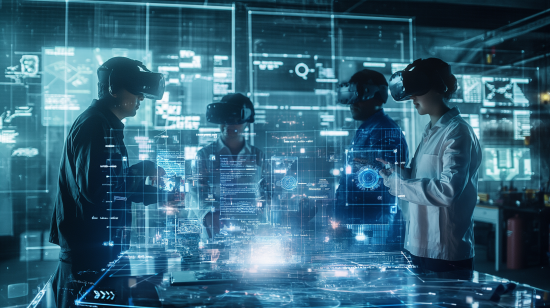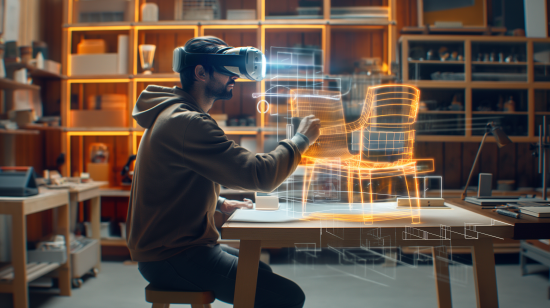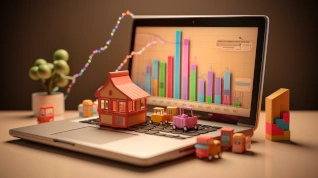VR, AR, MR, XR – a comparison of all technologies

In an era of relentless technological innovation, terms like AR (Augmented Reality), VR (Virtual Reality), MR (Mixed Reality), and XR (Extended Reality) are taking on tangible shapes, playing a pivotal role in shaping our future. These technologies are no longer just futuristic concepts; instead, they are becoming an integral part of our daily lives, opening new possibilities in various fields – from education to entertainment. In today’s article, we will explore the characteristics of each of these technologies, their diverse applications, and the impact they have on the modern world. We invite you to read on to better understand these groundbreaking innovations and their significance in today’s times.
AR, VR, MR, XR – an introduction
In the digital age technologies such as Augmented Reality (AR), Virtual Reality (VR), Mixed Reality (MR), and Extended Reality (XR) are revolutionizing the way we perceive and interact with the world.
- AR adds digital elements to the real world, making everyday experiences more interactive and enriched.
- VR transports us to a fully digital world, offering extraordinary experiences as if we were in another place or time.
- MR combines these two worlds, allowing us to interact with digital objects placed in our real environment.
- XR, on the other hand, is a term that encompasses the entire spectrum of these technologies, indicating their dynamic development and endless possibilities.
Let's delve a bit more into each of these technologies.
AR – digital elements in the real world
AR (Augmented Reality) is a technology that enriches the real world by adding digital elements to it. Users, viewing the real world through smartphone screens or special glasses, can experience additional information or virtual objects. This technology is particularly useful in education (see: AR in education), offering interactive learning methods, in commerce, facilitating shopping with product visualizations, and in tourism, where AR can enhance sightseeing with additional multimedia content. This innovative integration of the digital and real worlds opens up new possibilities in many areas of life.
VR – immersion in the digital world
Virtual Reality (VR) is a technology that offers complete immersion in a digital world. Users, using special devices such as VR helmets, are transported to virtual environments that can simulate both real and entirely fictional places. VR opens the door to new forms of entertainment, but also has wide applications in education, training, and therapy. Thanks to the ability to create realistic simulations, VR allows users to safely experience and explore different scenarios, which is a revolutionary step in many fields.
Read about immersive VR training.
Mixed Reality (MR): combining AR and VR
Mixed Reality (MR) combines elements of AR to create a unique environment where users can interact with virtual objects placed in the real world. This technology enables exceptional experiences where the digital world enhances reality, and real elements can be part of virtual scenarios. MR is applied in various fields, from education to spatial design, offering new ways to perceive and interact with the world.
Extended Reality (XR): the future of digital interactions
XR, or Extended Reality, is a term that encompasses VR, AR, and MR, as well as any other technologies that may emerge in the future, blending virtual and real elements. XR represents the evolution of digital interactions, offering possibilities for the merging of real and virtual worlds on an unprecedented scale. This could revolutionize the way we work, learn, and communicate, opening doors to unimaginable experiences that can be tailored to individual user needs.
What is the difference between AR and VR?
The primary difference between AR and VRlies in how they interact with the real world.
- AR adds digital elements to the real world, allowing the user to see and interact with virtual objects in the context of their surrounding space.
- In contrast, VR immerses the user in a completely virtual environment, cut off from reality, offering a fully immersive experience.
- In AR, the real world is the base that is enhanced with digital elements, whereas in VR, the user experiences a completely fabricated digital space.
How does VR differ from MR?
VR is a technology that transports the user to an entirely artificial world created digitally. It is an environment where all experiences – visual, auditory, and sometimes even tactile – are generated by a computer, creating a completely immersive environment. A VR user immerses themselves in this virtual world, often using special goggles and headphones, losing visual contact with physical reality.
Meanwhile, MR, or mixed reality, combines elements of virtual reality and augmented reality (AR), allowing interaction with both the physical world and virtual objects simultaneously. MR provides a more dynamic experience, enabling the user to see and manipulate virtual objects placed in their real environment.
This is made possible by advanced tracking and display technologies that allow for the precise overlay of digital images onto real objects and scenes.
In summary: while VR completely replaces the user's view, MR extends and enriches reality, creating a unique blend of the digital and physical world.
AR vs MR
AR and MR are two similar but distinctly different technology concepts.
- AR involves overlaying digital images or information onto the real world as seen by the user. An example is smartphone applications that overlay additional information or objects onto the camera's view. AR does not change the perception of the surroundings but rather expands it, enabling interaction with virtual elements placed in the real world.
- In contrast, MR represents a more advanced form of interaction. It allows not just for overlaying virtual objects on the real world but also for their integration and interaction in a way that seems natural and coherent. MR technology uses advanced systems for tracking and understanding space, enabling precise placement of virtual objects in reality and more complex interaction with them, such as manipulation or changing their position.
In summary, the main difference between AR and MR is the degree of integration and interaction of virtual elements with the real environment – AR extends reality, while MR creates a new one, mixing real and virtual elements.
Applications of AR, VR, MR, XR in different Industries
The technologies of AR, VR, MR, and XR are finding wide application in various industries.
- In education VR enables virtual trips and simulations that allow students to experience historical events or explore distant places.
- In medicine AR and MR are used to improve surgical procedures by overlaying important medical data onto the operating field.
- The gaming and entertainment industry utilizes VR and AR to create immersive experiences that transport players to alternative worlds or enhance the reality of mobile games.
- In the real estate sector, VR enables virtual tours of homes, which is particularly valuable for the international market.
- MR, on the other hand, is used in the manufacturing industry, allowing workers to interact with machines and production processes in a safe and efficient manner.
- XR also opens new possibilities in fields such as design, architecture, and engineering, offering tools for more interactive and collaborative design work.
Explore the 3D product configurator from SeeMyModel.
Challenges and prospects for the development of AR, VR, MR, and XR
The development of AR, VR, MR, and XR technologies faces many challenges. One key issue is ensuring user comfort, especially in the context of VR and MR, where problems such as dizziness or visual discomfort can be a barrier.
Privacy and security issues are also important, particularly in the context of collecting and processing personal data by AR and VR devices. Another challenge is accessibility and cost – high-quality VR and MR equipment is often expensive, limiting its availability to a wider audience. Despite these challenges, the prospects for the development of these technologies are promising.
Advances in miniaturization and computational efficiency pave the way for creating lighter, more comfortable, and more advanced devices. Simultaneously, the growing market interest and investments in the AR, VR, MR, and XR sector suggest that these technologies will increasingly impact many aspects of daily and professional life.
Do you like the post? Share to others!

Krzysztof Basista
COO
For years, he has been involved in AR / VR projects ranging from entertainment to heavy industry. Always looking for problem solving through technology.
Contact us
Related posts

In our era the blurring of boundaries between the physical and the digital world is becoming more apparent. A stark example of this trend is Mixed Reality (MR) technology...

In today's fast-paced technological world, one of the most fascinating achievements is augmented reality (AR).

In the era of digital transformation, consumer behaviors have undergone significant changes, redefining the way we make purchasing decisions and interact with brands. In this article...

In the era of digital commerce, where competition is at an all-time high and customer expectations are rising, the use of innovative technologies is becoming a key factor...

Today, retail stands at the crossroads between adaptation and revolution, facing rapidly changing technological trends. In our article today, we will explore how modern...

Augmented reality (AR) is a technology that combines the physical and digital worlds to create an interactive experience. AR technology is used in a variety of industries...





